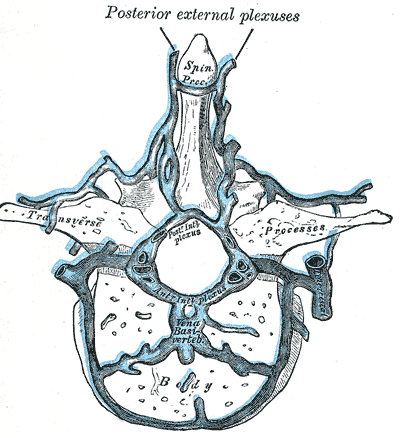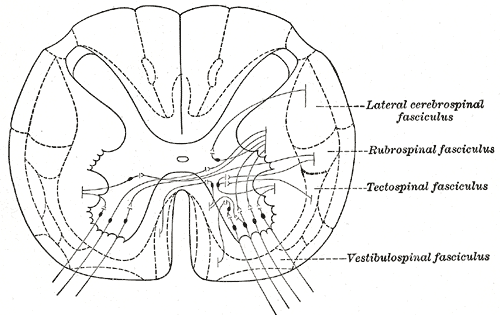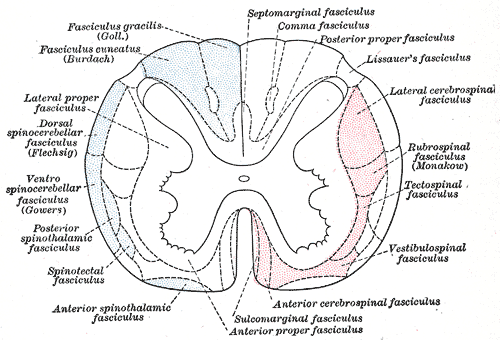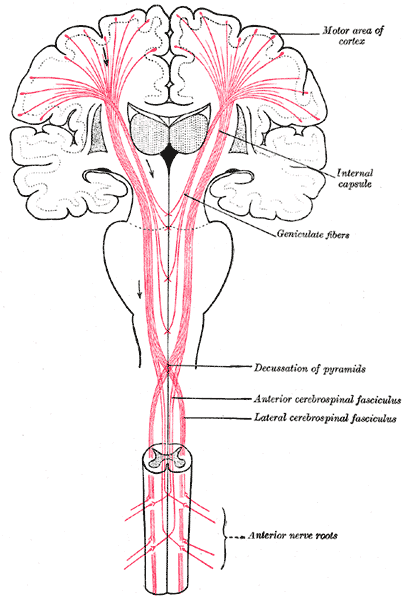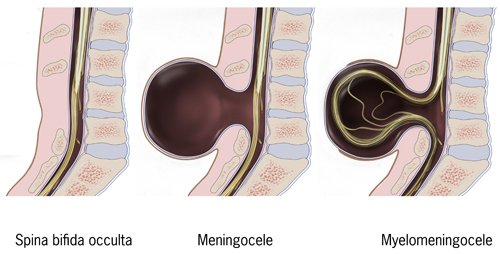[1]
Boonpirak N, Apinhasmit W. Length and caudal level of termination of the spinal cord in Thai adults. Acta anatomica. 1994:149(1):74-8
[PubMed PMID: 8184662]
[2]
Bhat AR, Kirmani AR, Wani MA, Bhat MH. Incidence, histopathology, and surgical outcome of tumors of spinal cord, nerve roots, meninges, and vertebral column - Data based on single institutional (Sher-i-Kashmir Institute of Medical Sciences) experience. Journal of neurosciences in rural practice. 2016 Jul-Sep:7(3):381-91. doi: 10.4103/0976-3147.181489. Epub
[PubMed PMID: 27365955]
[3]
Bican O, Minagar A, Pruitt AA. The spinal cord: a review of functional neuroanatomy. Neurologic clinics. 2013 Feb:31(1):1-18. doi: 10.1016/j.ncl.2012.09.009. Epub
[PubMed PMID: 23186894]
[4]
Ko HY, Park JH, Shin YB, Baek SY. Gross quantitative measurements of spinal cord segments in human. Spinal cord. 2004 Jan:42(1):35-40
[PubMed PMID: 14713942]
[6]
Petkó M, Antal M. Propriospinal pathways in the dorsal horn (laminae I-IV) of the rat lumbar spinal cord. Brain research bulletin. 2012 Oct 1:89(1-2):41-9. doi: 10.1016/j.brainresbull.2012.06.005. Epub 2012 Jun 23
[PubMed PMID: 22732529]
[7]
Krotov V, Tokhtamysh A, Kopach O, Dromaretsky A, Sheremet Y, Belan P, Voitenko N. Functional Characterization of Lamina X Neurons in ex-Vivo Spinal Cord Preparation. Frontiers in cellular neuroscience. 2017:11():342. doi: 10.3389/fncel.2017.00342. Epub 2017 Nov 1
[PubMed PMID: 29163053]
[8]
Cho TA. Spinal cord functional anatomy. Continuum (Minneapolis, Minn.). 2015 Feb:21(1 Spinal Cord Disorders):13-35. doi: 10.1212/01.CON.0000461082.25876.4a. Epub
[PubMed PMID: 25651215]
[9]
Berkowitz C. DEFINING A DISCOVERY: PRIORITY AND METHODOLOGICAL CONTROVERSY IN EARLY NINETEENTH-CENTURY ANATOMY. Notes and records of the Royal Society of London. 2014 Dec 20:68(4):357-72
[PubMed PMID: 27494015]
Level 3 (low-level) evidence
[10]
Frostell A, Hakim R, Thelin EP, Mattsson P, Svensson M. A Review of the Segmental Diameter of the Healthy Human Spinal Cord. Frontiers in neurology. 2016:7():238. doi: 10.3389/fneur.2016.00238. Epub 2016 Dec 23
[PubMed PMID: 28066322]
[11]
Darnell D, Gilbert SF. Neuroembryology. Wiley interdisciplinary reviews. Developmental biology. 2017 Jan:6(1):. doi: 10.1002/wdev.215. Epub 2016 Dec 1
[PubMed PMID: 27906497]
[12]
Lai HC, Seal RP, Johnson JE. Making sense out of spinal cord somatosensory development. Development (Cambridge, England). 2016 Oct 1:143(19):3434-3448
[PubMed PMID: 27702783]
[13]
Ami N, Bernstein M, Boucher F, Rieder M, Parker L, Canadian Paediatric Society, Drug Therapy and Hazardous Substances Committee. Folate and neural tube defects: The role of supplements and food fortification. Paediatrics & child health. 2016 Apr:21(3):145-54
[PubMed PMID: 27398055]
[14]
Lara-Ramírez R, Zieger E, Schubert M. Retinoic acid signaling in spinal cord development. The international journal of biochemistry & cell biology. 2013 Jul:45(7):1302-13. doi: 10.1016/j.biocel.2013.04.002. Epub 2013 Apr 8
[PubMed PMID: 23579094]
[15]
Melton KR, Iulianella A, Trainor PA. Gene expression and regulation of hindbrain and spinal cord development. Frontiers in bioscience : a journal and virtual library. 2004 Jan 1:9():117-38
[PubMed PMID: 14766352]
[16]
Takahashi T, Takase Y, Yoshino T, Saito D, Tadokoro R, Takahashi Y. Angiogenesis in the developing spinal cord: blood vessel exclusion from neural progenitor region is mediated by VEGF and its antagonists. PloS one. 2015:10(1):e0116119. doi: 10.1371/journal.pone.0116119. Epub 2015 Jan 13
[PubMed PMID: 25585380]
[17]
Sinescu C, Popa F, Grigorean VT, Onose G, Sandu AM, Popescu M, Burnei G, Strambu V, Popa C. Molecular basis of vascular events following spinal cord injury. Journal of medicine and life. 2010 Jul-Sep:3(3):254-61
[PubMed PMID: 20945816]
[18]
Statland JM, Barohn RJ, McVey AL, Katz JS, Dimachkie MM. Patterns of Weakness, Classification of Motor Neuron Disease, and Clinical Diagnosis of Sporadic Amyotrophic Lateral Sclerosis. Neurologic clinics. 2015 Nov:33(4):735-48. doi: 10.1016/j.ncl.2015.07.006. Epub 2015 Sep 8
[PubMed PMID: 26515618]
[19]
Azam B, Wienecke J, Jensen DB, Azam A, Zhang M. Spinal Cord Hemisection Facilitates Aromatic L-Amino Acid Decarboxylase Cells to Produce Serotonin in the Subchronic but Not the Chronic Phase. Neural plasticity. 2015:2015():549671. doi: 10.1155/2015/549671. Epub 2015 Oct 4
[PubMed PMID: 26504602]
[20]
Engelborghs S, Niemantsverdriet E, Struyfs H, Blennow K, Brouns R, Comabella M, Dujmovic I, van der Flier W, Frölich L, Galimberti D, Gnanapavan S, Hemmer B, Hoff E, Hort J, Iacobaeus E, Ingelsson M, Jan de Jong F, Jonsson M, Khalil M, Kuhle J, Lleó A, de Mendonça A, Molinuevo JL, Nagels G, Paquet C, Parnetti L, Roks G, Rosa-Neto P, Scheltens P, Skårsgard C, Stomrud E, Tumani H, Visser PJ, Wallin A, Winblad B, Zetterberg H, Duits F, Teunissen CE. Consensus guidelines for lumbar puncture in patients with neurological diseases. Alzheimer's & dementia (Amsterdam, Netherlands). 2017:8():111-126. doi: 10.1016/j.dadm.2017.04.007. Epub 2017 May 18
[PubMed PMID: 28603768]
Level 3 (low-level) evidence
[21]
Bos EME, Hollmann MW, Lirk P. Safety and efficacy of epidural analgesia. Current opinion in anaesthesiology. 2017 Dec:30(6):736-742. doi: 10.1097/ACO.0000000000000516. Epub
[PubMed PMID: 28938298]
Level 3 (low-level) evidence
[22]
Elsharkawy H, Sonny A, Chin KJ. Localization of epidural space: A review of available technologies. Journal of anaesthesiology, clinical pharmacology. 2017 Jan-Mar:33(1):16-27. doi: 10.4103/0970-9185.202184. Epub
[PubMed PMID: 28413269]
[23]
Hogan QH, Mark L. Subdural injection: what's the gold standard? Regional anesthesia and pain medicine. 2009 Jan-Feb:34(1):10-1. doi: 10.1097/AAP.0b013e31819268a0. Epub
[PubMed PMID: 19258981]
[24]
Boezaart AP, Lucas SD, Elliott CE. Paravertebral block: cervical, thoracic, lumbar, and sacral. Current opinion in anaesthesiology. 2009 Oct:22(5):637-43. doi: 10.1097/ACO.0b013e32832f3277. Epub
[PubMed PMID: 19680122]
Level 3 (low-level) evidence
[25]
Hoffman O, Weber RJ. Pathophysiology and treatment of bacterial meningitis. Therapeutic advances in neurological disorders. 2009 Nov:2(6):1-7. doi: 10.1177/1756285609337975. Epub
[PubMed PMID: 21180625]
Level 3 (low-level) evidence
[26]
Luo M, Wang W, Zeng Q, Luo Y, Yang H, Yang X. Tuberculous meningitis diagnosis and treatment in adults: A series of 189 suspected cases. Experimental and therapeutic medicine. 2018 Sep:16(3):2770-2776. doi: 10.3892/etm.2018.6496. Epub 2018 Jul 20
[PubMed PMID: 30210618]
Level 3 (low-level) evidence
[27]
Marx GE, Chan ED. Tuberculous meningitis: diagnosis and treatment overview. Tuberculosis research and treatment. 2011:2011():798764. doi: 10.1155/2011/798764. Epub 2011 Dec 21
[PubMed PMID: 22567269]
Level 3 (low-level) evidence
[28]
Alizadeh A, Dyck SM, Karimi-Abdolrezaee S. Traumatic Spinal Cord Injury: An Overview of Pathophysiology, Models and Acute Injury Mechanisms. Frontiers in neurology. 2019:10():282. doi: 10.3389/fneur.2019.00282. Epub 2019 Mar 22
[PubMed PMID: 30967837]
Level 3 (low-level) evidence
[29]
Malhotra M, Bhatoe HS, Sudambrekar SM. Spinal Cord Injuries. Medical journal, Armed Forces India. 2010 Oct:66(4):325-8. doi: 10.1016/S0377-1237(10)80009-7. Epub 2011 Jul 21
[PubMed PMID: 27365735]
[30]
Klakeel M, Thompson J, Srinivasan R, McDonald F. Anterior spinal cord syndrome of unknown etiology. Proceedings (Baylor University. Medical Center). 2015 Jan:28(1):85-7
[PubMed PMID: 25552812]
[31]
Silva Macedo Y, Dos Santos Mota A, Morais Monteiro P, Carvalho AC, Fernandes Diniz B, Gemal Lanzieri P, Carneiro Ramos R, Mocarzel LO, Gismondi RA. Posterior Cord Syndrome and Trace Elements Deficiency as an Uncommon Presentation of Common Variable Immunodeficiency. Case reports in medicine. 2017:2017():9870305. doi: 10.1155/2017/9870305. Epub 2017 Mar 5
[PubMed PMID: 28356913]
Level 3 (low-level) evidence
[32]
Divi SN, Schroeder GD, Mangan JJ, Tadley M, Ramey WL, Badhiwala JH, Fehlings MG, Oner FC, Kandziora F, Benneker LM, Vialle EN, Rajasekaran S, Chapman JR, Vaccaro AR. Management of Acute Traumatic Central Cord Syndrome: A Narrative Review. Global spine journal. 2019 May:9(1 Suppl):89S-97S. doi: 10.1177/2192568219830943. Epub 2019 May 8
[PubMed PMID: 31157150]
Level 3 (low-level) evidence
[33]
Wang C, Zhao JJ, Lu CL, Han XD, An LS, Ma X. Polycomb group proteins are essential for spinal cord development. Frontiers in bioscience (Landmark edition). 2010 Jun 1:15(3):1018-22
[PubMed PMID: 20515739]
[34]
Darbar A, Krishnamurthy S, Holsapple JW, Hodge CJ Jr. Ventral thoracic spinal cord herniation: frequently misdiagnosed entity. Spine. 2006 Aug 1:31(17):E600-5
[PubMed PMID: 16924199]
[36]
Klekamp J. How Should Syringomyelia be Defined and Diagnosed? World neurosurgery. 2018 Mar:111():e729-e745. doi: 10.1016/j.wneu.2017.12.156. Epub 2018 Jan 6
[PubMed PMID: 29317358]
[37]
Gürsoy AE, Kolukısa M, Babacan-Yıldız G, Celebi A. Subacute Combined Degeneration of the Spinal Cord due to Different Etiologies and Improvement of MRI Findings. Case reports in neurological medicine. 2013:2013():159649. doi: 10.1155/2013/159649. Epub 2013 Mar 27
[PubMed PMID: 23607009]
Level 3 (low-level) evidence

